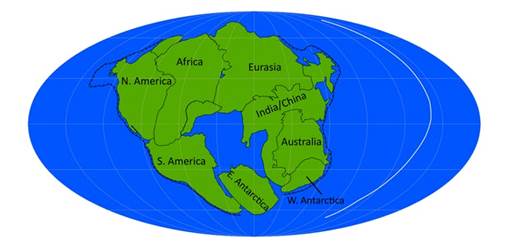Description

Disclaimer: Copyright infringement not intended.
Context
- Earth’s continents were formed by massive meteorite impacts that were prevalent during the first billion years of our planet’s four and a half billion-year history, according to a new study.

Further findings of the new Study
- Meteorite impacts generated massive energy to form oceanic plates, which later evolved into continents.
- The most commonly accepted theory in place attributes continent formation to the movement of tectonic plates.
- The theory that giant meteorite impacts formed continents had been around for decades, but until now, there was little solid evidence for its support.
- The new study provides some concrete evidence supporting the big impact theory.
|
Big Impact Theory
A theory that explains the origins of Earth's moon, postulating that an asteroid roughly the size of Mars impacted the Earth during its formation. This impact resulted in rocky surface material being blown outward from the Earth, some of which accreted to form the Moon.
|
The Research
- The researchers looked for evidence in zircon crystals embedded in rocks from the Pilbara Craton in Western Australia. This craton is the remnant of an ancient crust that began forming more than three billion years ago.
- Zircons are formed by the crystallisation of magma or are found in metamorphic rocks. They act as tiny time capsules, recording the period of geologic activity. Newer zircon adds to the original crystal as time progresses.
- Johnson and his colleagues studied the variants or isotopes of oxygen within these crystals: oxygen-18 and oxygen-16. The ratio between the two variants helped scientists estimate past temperatures.
- Older grains of zircon possessed the lighter oxygen-16. The younger ones contained the heavier oxygen-18.
- This pattern suggests the Pilbara Craton began with extensive melting of shallow, near-surface rocks, with subsequent melting occurring at successively deeper levels.
- The giant meteorite hit Earth and melted the outer shell of the Earth or the lithosphere, according to the study.
- This impact released the pressure on the underlying mantle. As a result, the mantle likely melted, creating an oceanic plateau.
- This is similar to a lump forming after being struck on the head by a stone or a cricket ball, according to the expert.
- If the oceanic plateau gets big enough, it can melt at its base to form granite, which is what the continents are made of. Granite requires both water and energy to form.
- Other rocky planets and the moon have had a history of meteorite impacts. But they had little or no water by the time the flux of effects declined.
https://www.downtoearth.org.in/news/science-technology/how-did-continents-form-giant-meteorite-impacts-could-be-responsible-says-study-84284















